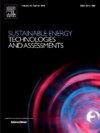Ukraine’s biogas potential: a comprehensive assessment of energy yields and of feedstock availability
IF 7.1
2区 工程技术
Q1 ENERGY & FUELS
Sustainable Energy Technologies and Assessments
Pub Date : 2025-06-24
DOI:10.1016/j.seta.2025.104412
引用次数: 0
Abstract
The manuscript is devoted to determining the biogas potential of Ukraine by assessing the energy yields of agricultural substrates and their availability. A systematic analysis was used to study the energy capacity of biomass and analyze the strategies for biogas sector development. The potential of the agricultural biogas production in Ukraine (from livestock and crop residues) and their availability were evaluated. Agricultural biogas potential of Ukraine was estimated at 15438.75 million m3 of biogas per year (approx. 8.8 billion m3/year of biomethane), potentially replacing one-third of the country’s natural gas consumption. The majority of the potential comes from crop residues (mainly corn and sunflower straw) contributing over 80% of the total biogas potential. There are some regional variations (with central and eastern regions showing the highest capacity) but biogas solutions could be implemented across all Ukraine. Biogas plants could generate 4.37 GW of electricity, significantly contributing to overcoming Ukraine’s energy crisis. Ukraine’s existing gas infrastructure and EU-aligned policy goals support rapid biogas scaling. Biogas could meet up to one-third of national gas demand, while biomethane offers strong export potential and long-term energy resilience for Ukraine and the EU.

乌克兰的沼气潜力:能源产量和原料可用性的综合评估
该手稿致力于通过评估农业基质的能源产量及其可用性来确定乌克兰的沼气潜力。通过系统分析,研究了生物质的能源容量,并分析了沼气产业的发展策略。评估了乌克兰农业沼气生产的潜力(来自牲畜和作物残茬)及其可得性。乌克兰的农业沼气潜力估计为每年1543875万立方米。88亿立方米/年的生物甲烷),有可能取代该国三分之一的天然气消费量。大部分潜力来自作物秸秆(主要是玉米和向日葵秸秆),贡献了总沼气潜力的80%以上。有一些地区差异(中部和东部地区显示出最高的容量),但沼气解决方案可以在整个乌克兰实施。沼气发电厂可以产生4.37吉瓦的电力,为克服乌克兰的能源危机做出了重大贡献。乌克兰现有的天然气基础设施和与欧盟一致的政策目标支持快速扩大沼气规模。沼气可以满足乌克兰三分之一的天然气需求,而生物甲烷为乌克兰和欧盟提供了强大的出口潜力和长期的能源弹性。
本文章由计算机程序翻译,如有差异,请以英文原文为准。
求助全文
约1分钟内获得全文
求助全文
来源期刊

Sustainable Energy Technologies and Assessments
Energy-Renewable Energy, Sustainability and the Environment
CiteScore
12.70
自引率
12.50%
发文量
1091
期刊介绍:
Encouraging a transition to a sustainable energy future is imperative for our world. Technologies that enable this shift in various sectors like transportation, heating, and power systems are of utmost importance. Sustainable Energy Technologies and Assessments welcomes papers focusing on a range of aspects and levels of technological advancements in energy generation and utilization. The aim is to reduce the negative environmental impact associated with energy production and consumption, spanning from laboratory experiments to real-world applications in the commercial sector.
 求助内容:
求助内容: 应助结果提醒方式:
应助结果提醒方式:


